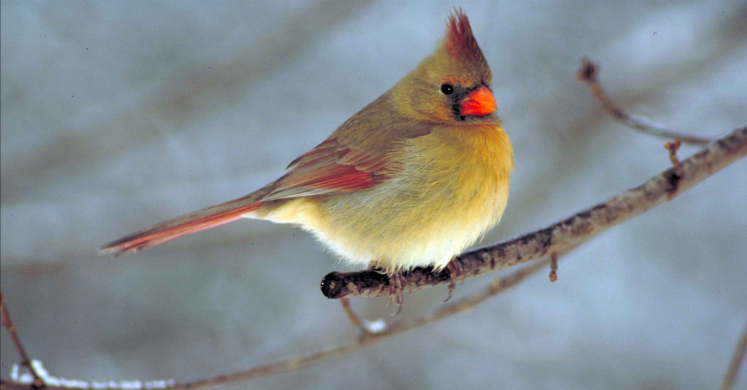Blog

#bioPGH Blog: Northern Cardinals
 A resource of Biophilia: Pittsburgh, #bioPGH is a weekly blog and social media series that aims to encourage both children and adults to reconnect with nature and enjoy what each of our distinctive seasons has to offer.
A resource of Biophilia: Pittsburgh, #bioPGH is a weekly blog and social media series that aims to encourage both children and adults to reconnect with nature and enjoy what each of our distinctive seasons has to offer.
Now that the leaves are off the trees, one visitor to my bird feeder is particularly easy to spot — the bright red male Northern Cardinal (Cardinalis cardinalis). The female counterpart, free of the obligation to ostentatiously impress a mate, has a more muted blend of tan and pale orange colors to define her plumage, but she is no less a pleasant sight around the feeder. Since cardinals don’t migrate, they are year-round residents and we are seeing the same birds in the spring and summer as in the fall and winter. Like so many aspects of nature, there is more to them than meets the eye — from their gutsy, bold personalities to the way they have adapted to our human presence. Let’s get to know these feathered neighbors a bit better!
Cardinals are a bright songbird in, fittingly, the Cardinalidae family. They have adapted very well to the presence of humans, and though they naturally prefer shrubby thickets or open forest habitats, they can be found quite readily in areas with a strong human presence like in the landscaping of neighborhoods and businesses or along the edges of park meadows and fields. Their preferred diet is seeds, which is why they are so common at bird feeders.
One reason I am so intrigued by these bright birds is their feisty personality. Male cardinals particularly have a strong territorial streak to match their fire-red feathers. Have you ever noted a cardinal (male or female, really) pecking at its own reflection in a window or outdoor mirror? They are fiercely dedicated to protecting their territories, especially during the breeding season. While nesting, the less-conspicuous females tend to stay on the eggs while the males respond defensively to any intruder to their little domains (and yes…I have been scolded by a cardinal for presumably wandering too close to a hidden nest). Compared to us, they may be small, but they certainly are mighty!
Another reason to appreciate Northern Cardinals is because we can learn so much from them. Since the species is so widespread and well-adapted to human activities, we can take note of what effect our human-based changes to the environment have had on their behavior, activities, and even morphology. For example, cardinals have traditionally been native to Central America, Mexico and eastern and southwestern United States. But like many other bird species, cardinals have slowly but surely been expanding north into Canada in the past few decades as climate change alters habitat conditions (though, intriguingly, it is also speculated bird feeders have greatly assisted cardinals in particular in making this move northward). Cardinals were also the focus of a study that noted urbanization and climate seem to have an effect on bill size (birds have different ways to manage heat since they can’t sweat, and bill size seems to play a role in it for some kinds of birds). Alongside robins, cardinals were also the focus of a study that found birds can change their songs in busy, loud, urbanized areas to ensure that their songs are heard over a commotion of human noise.
So the next time you happen to spot a flash of red in the brush or at your feeder, remember there is more to them to than meets the eye — like all of nature.
Connecting to the Outdoors Tip: If you're interested in birds and birding, check out our upcoming Fairchild Challenge for middle school and high school students!
Continue the Conversation: Share your nature discoveries with our community by posting to Twitter and Instagram with hashtag #bioPGH, and R.S.V.P. to attend our next Biophilia: Pittsburgh meeting.
Resources
Audubon Society: Survival by Degrees
National Geographic: Rising temperatures could make some U.S. state birds ‘stateless’
The Cornell Lab – Northern Cardinal
Audubon Society – Northern Cardinal
USDA Forest Service – Climate Change Scenario Maps
Bird populations shift north as climate changes
Bill size variation in northern cardinals associated with anthropogenic drivers across North America
Photo credits: Cover, USFWS public domain; Header, Pixabay

